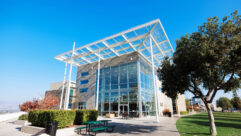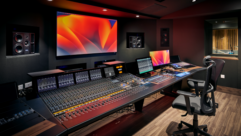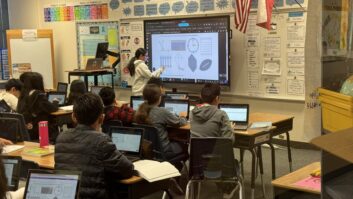To avoid oversimplifying the concept,let’s view green AV as a collection of ideas, perhaps even as a movement composed of organizations, companies, and individuals. The players in the movement share the common goal of discovering how best to use technology with minimal environmental impact.
If there’s one question that kicks off virtually every professional discussion I have, it is, of course, “What is green AV?” My response typically goes like, “Ahem. Uh, yes.” I confess that I have yet to come up with a quick, two-line, glossary definition of “green AV.” I try to sound scholarly and witty, but the two-liners I try never do justice to the concept of green AV. To avoid oversimplifying the concept, I instead propose that we view green AV as a collection of ideas, perhaps even as a movement composed of organizations, companies, and individuals. The players in the movement share the common goal of discovering how best to use technology with minimal environmental impact.
While efforts to develop green AV are still mostly unstructured, the passion for and belief in the cause have led to a gradual collaboration and a general consensus on the environmental factors to target. Green AV does not just mean energy consumption, but comprises issues of waste reduction and management, operational efficiency, and responsible manufacturing processes and materials.
To date, the primary case for green AV involves a loose but concerted attempt by leaders in our industry to integrate AV into the U.S. Green Building Council’s Leadership in Energy and Environmental Design certification (www.usgbc.org/LEED).
As you may know, when qualifying for LEED certification, different elements of a project count as points on a scoring checklist. There are potential opportunities for green-enabling AV under several scoring headers, including Sustainable Sites (reduce need for travel); Energy & Atmosphere (energy efficiency, measurement, and verification); Materials & Resources (decrease in raw material input, waste management); and Indoor Environmental Quality (control systems). There’s also a heading called Innovation, which is an area of extra credit, so to speak, where points are awarded for going above and beyond minimum standards.
For now, getting LEED recognition for AV contributions is an uphill battle (see “The Movement Builds”). It will take the combined efforts of our industry to get USGBC’s full attention.
In late 2008, hoping to facilitate collaboration on green AV programs, InfoComm gathered 20 AV design, integration, consulting, manufacturing, and rental and staging professionals. Until then, all had been working independently to develop the working definition of green AV and strategies for implementing it.
Out of the inaugural Green AV Summit came the goal to establish a task force that would develop a body of knowledge, provide educational opportunities for the entire industry, and perhaps most importantly create an advocacy program for green AV. The group came away resolute in the understanding that our industry’s largest professional association saw green AV as both necessary to our continued quality of life and a viable business opportunity.
What’s happening now?
In a recent interview, I was asked if I would compare the green AV movement to a child in the early stages of learning to walk. Frankly, I replied, I see us as more at the crawling phase, enjoying an exploratory state of newly discovered mobility and an expanded vision of our world, but not quite on our legs yet.
A positive sign of change has been a recent move from ensuring our own organizations are doing the right thing to a newfound responsibility to share our best practices and knowledge.
At Sonic Foundry, a company that makes a Web-casting platform, the practice of “take-backs” has been a core offering for years. Sonic Foundry and others seek to prevent the dumping of potentially hazardous waste by taking back products at the end of their life cycle. It’s not “green” in terms of energy-efficiency, which has long been the sole focus in an AV industry where our traditional products and services sometimes consume massive energy resources, but green nonetheless. With guidance, these types of programs could become models for the entire AV industry–and beyond.
Paul Depperschmidt, CTS, director of sales for Polycom (a conferencing vendor that has a vested interest in green applications), had his own epiphany that had nothing to do with reducing carbon footprints through telepresence. He had a chance to check out AVWorkz’s A/V Systems Monitoring service. “This could be a step to capturing much-needed data for the actual, real-time energy used by AV technologies,” Depperschmidt says. “Not the estimates on a manufacturer’s spec sheet.”
In short, this will be the year green AV gains momentum. After all, is it really a movement if nothing’s moving?
One thing that will drive momentum is the “green-collar effect,” the idea that as requirements for green technology, products, and services increase under a new government administration, basic job functions will adapt to fulfill those requirements. The example most commonly cited is the plumber who begins to install solar-powered water heaters.
Perhaps AV designers will be expected to source the best alternative energy for their plans. Clients might need their AV consultant to recommend the most responsible means of disposal for outdated gear. In other words, the scope of services offered by AV professionals will expand–and that should be seen as a bright opportunity in an otherwise dark economic forecast.
In his book, “Greed to Green,” David Gottfried, founder of USGBC, talks about challenges in establishing standards for a green building industry. With no precedent to build on, Gottfried’s group was unsure where it was headed. “But we were asking questions,” he says, “and that’s how change begins.”
AV pros need to ask questions, too. Empowered by knowledge, we’ll find ways we can apply existing technology to support green initiatives. Green AV is our concept to develop. We should collaborate, question, and create. Then positive change will begin.
Midori Connolly is CEO of Pulse Staging and Events in San Diego, a member of the Green Meeting Industry Council, a corporate social responsibility trainer for Meeting Professionals International, and an InfoComm lecturer on green AV topics. Her column will appear bi-monthly in Pro AV.










